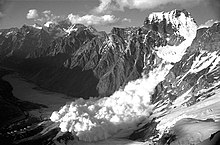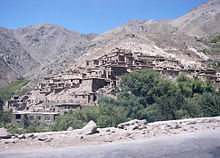User:Cool-collie/sandbox

Geographical Impact
[edit]Avalanches are a common hydro-meteorological hazard affecting many areas of Afghanistan. 9 of the 34 Provinces are classed as high avalanche risk (including Panjshir, Badakhshan, Bamyan) and 14 at medium risk.[1] The avalanches in February 2015 were the worst to affect Afghanistan in over 30 years.[2] Following an unusually dry, mild winter an unprecedented amount of snow fell over 48 hours, 6 feet in places, that blocked roads connecting 20 valleys. [3][4]
In Afghanistan's mountain ranges around 80% of annual precipitation falls as snow. The region affected was at the juncture between the Hindu Kush and Pamir mountains where the topography and climate undoubtedly contributed to the disaster. The region’s characteristics include high-angled slopes, 7000m peaks, deep gorges, and steep sided valleys, major snowstorms and avalanches are commonplace. The steep slopes facilitate the accumulation of snow, several active fault lines can trigger seismic activity dislodging snow slabs, and variations in temperature at the rock/ice interface cause the ice to melt improving the glide of the snow. These factors increase the probability of avalanche especially when coupled with unusually heavy snowfall.[1] Reports from the International Federation of Red Cross and Red Crescent Societies have suggested the winter season is getting longer, previously ending in January it now extends into March.[5] Rising temperatures due to climate change might reduce the risk of avalanche in lower regions, but higher areas are likely to be at greater risk due to increased snowfall.[6]

Snowmelt in spring and summer sustains the agriculture that Afghanistan's rural populations rely on.[7] Traditionally valley bottoms are reserved for farming and rural communities inhabit villages on slopes at risk of avalanche.[6] Reports suggest 250,000 Afghans per year are displaced by natural disasters,[5] but it seems communities in high risk avalanche areas are unaware of the severity of their situation, cannot afford to move or find alternative land to settle on.[1] This leaves many in vulnerable circumstances.

References
[edit]- ^ a b c Bharam, Ikramuddin (2015-03-10). "A Perfect (Snow) Storm: What can be done against avalanche damage in Afghanistan". Afghanistan Analysts Network - English (in Pashto). Retrieved 2022-10-23.
- ^ Harooni, Mirwais (2015-02-26). "Avalanches kill 186 in Afghanistan". Reuters. Retrieved 2022-10-25.
- ^ Mukhtar, Ahmad (27 February 2015). "Afghan avalanche death toll passes 220". www.cbsnews.com. Retrieved 2022-10-25.
- ^ "Death toll climbs in Afghanistan avalanches". www.cbsnews.com. 26 February 2015. Retrieved 2022-10-25.
- ^ a b "Afghanistan - Complex Emergency Fact Sheet #4, Fiscal Year (FY) 2015 - Afghanistan | ReliefWeb". reliefweb.int. 16 October 2015. Retrieved 2022-10-23.
- ^ a b "Disaster risk profile: Afghanistan". www.preventionweb.net. February 2017. Retrieved 2022-10-23.
- ^ Kabul, Reuters in (2015-02-26). "Afghanistan avalanches: more than 180 dead". the Guardian. Retrieved 2022-10-23.
{{cite web}}:|first=has generic name (help)
